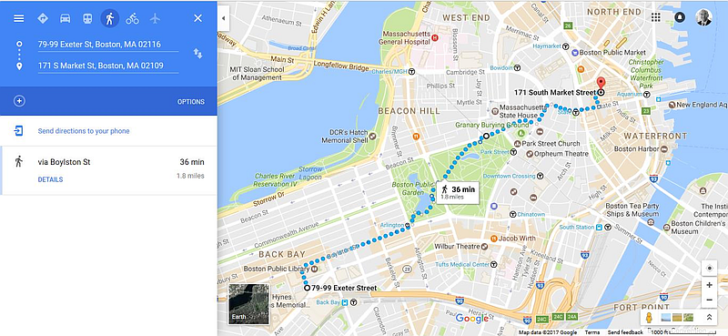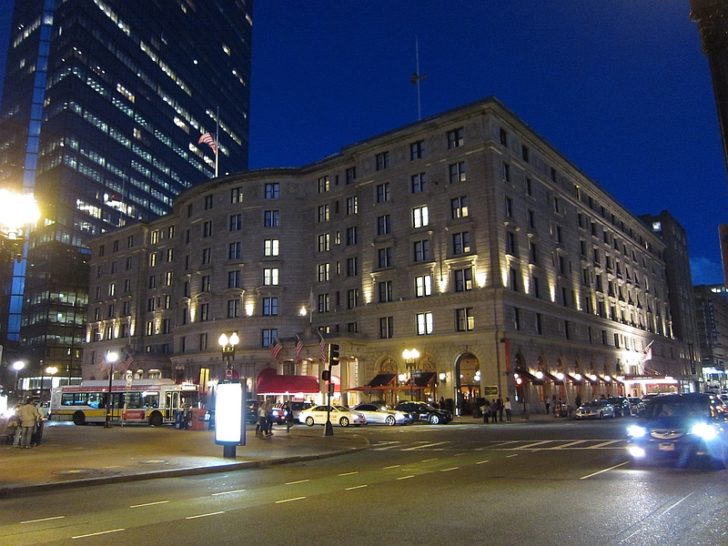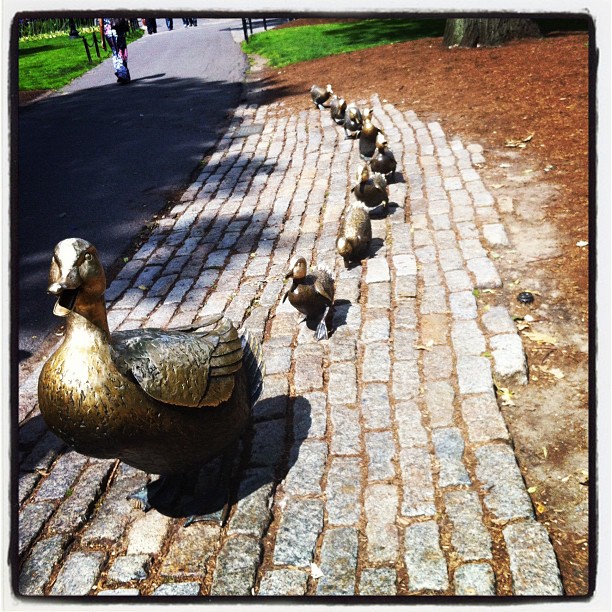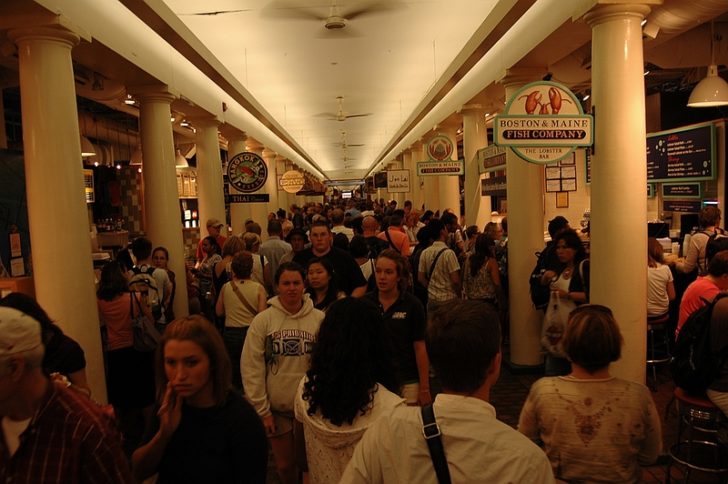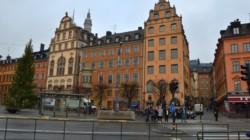With my flight home on jetBlue not scheduled until 2:40 pm, I had the entire morning free for exploring Boston. Thanks to crisp but sunny weather, I decided to create my own walking tour. The Copley Square Hotel made for a good starting point in the Back Bay. With no particular plan, I headed in the general direction of Boston Common and downtown, hoping to see as much of the city as I could.
Eventually, my self-guided tour first entailed a walk up Boylston Street to the Common. From there, I continued to the Massachusetts State House, where I picked up the Freedom Trail. I followed that to Faneuil Hall and the Faneuil Hall Marketplace. Finally, after grabbing a quick breakfast at the Marketplace, I retraced my steps back to the hotel. The entire tour spanned roughly 1 3/4 miles each way, and took two hours to complete. Below is a map of my rough route for your viewing pleasure.
NOTE: this is NOT intended as a comprehensive guide to the city. Of course, Boston is a vibrant city, and one morning barely scratches the surface. Rather, this is intended as a suggestion if you only have a couple of hours to stretch your legs. In case you’re wondering why I didn’t go inside any of the monuments I passed – I can easily spend two hours just looking around a museum. Simply put, no time for that on this day. If you have a couple of days to spend, consider this a suggested starting point of sights to explore further.
Copley Square
Though a bit out of downtown proper, Copley Square is one of the city’s most historically significant public squares. Dating to the 19th century, many of Boston’s cultural and educational institutions located near Copley Square. Though some, such as Boston University, eventually relocated elsewhere, many others remain today. Among the best known is the massive Boston Public Library. Completed in 1895, the Italian Renaissance-style library cost the princely sum of $2.268 million to build.
Also along the square are two of the city’s historic churches. Just northwest of the square sits Old South Church, built in 1873. It is considered one of the finest Victorian Gothic Revival churches in New England.
The east end of the square features the Romanesque Revival Trinity Church, built in 1877. Parishioners constructed the church on its new location following the Great Fire of 1872.
And of course, if you’re just in the mood for a little nature, you can enjoy a little fall foliage with your walk.
Meanwhile, if you’re in the mood for a drink, head over to the historic Fairmont Copley Plaza hotel. I didn’t have a chance to stop in, but I hear the martini service is second to none.
Since 1986, the northwest corner of Copley Square marks the end of the line for the Boston Marathon. Tragically, this also made the area around the square, just west along Boylston Street, ground zero for the Marathon bombings on April 15, 2013.
The Boston Public Garden
After admiring the architecture for a bit, I headed east on Boylston Street, eventually reaching the Boston Public Garden. Though built 200 years after the adjacent Boston Common, the garden is significant in its own right. It is America’s first public botanical garden, featuring colorful floral displays and imported trees. This time of year, the main attraction was fall foliage, especially around the lagoon.
The foliage is most vibrant north of the bridge halfway across. To the right of the bridge are the “Swan Boats“. As the name implies, these are swan-shaped pedal boats that take you on a tour of the lagoon. The boats operate mid-April through mid-September.
Also in abundance at the lagoon – lots of ducks.
Also on the north side of the garden are the cute “Make Way for Ducklings” statues. I unfortunately didn’t know about this until an Instagram friend told me about it weeks later. Which is too bad, because it’s pretty cool.
The Boston Common
Following a stroll around the south side of the lagoon, I crossed Charles Street to the famous Boston Common. The Common reigns as the oldest city park in America, dedicated in 1634. However, “true” park status probably didn’t occur until about 1830, when the mayor banned grazing cows on the grounds. Historically, the Common had a rather macabre use, as the site of public hangings. Today, it’s a true park, providing nice views of the skylines of both downtown and the Back Bay. And of course, the trees ablaze with color made for an idyllic big city scene.


Meanwhile, in roughly the center of the Common, you’ll find the Soldiers and Sailors Monument, atop Flag Staff Hill. Dedicated in 1877, the monument is a tribute to the Massachusetts soldiers and sailors who died during the Civil War. It rises to a height of 126 feet, and features four bas-relief bronze tablets at its base. Up top? A female figure titled “America”, holding an American flag and surrounded by 13 stars.
The Massachusetts State House
After taking some photos of the city from the Soldiers and Sailors monument, I headed to the northeast corner of the Common and the Massachusetts State House. Completed in 1798 by noted architect Charles Bulfinch, and its cornerstone laid by Samuel Adams in 1795, the building is best known for its gilded dome. None other than Paul Revere originally covered the wood dome in sheets of rolled copper. Later remodelings added the gold plating you see today. The building still houses the Massachusetts legislature and governor’s offices. Free, guided walk tours are offered from 10 am-3 pm weekdays.
The Old South Meeting House
From the State House, I headed down the Freedom Trail towards the heart of downtown. First stop on the trail: the Old South Meeting House, one of the most important sites in colonial American history. The Meeting House dates to 1729, as a meeting place for Puritans to worship. That alone makes it historically significant, but pales in comparison to what happened on December 16, 1773. On that day, 5,000 colonists meet here to decide what to do about 30 tons of tea which recently arrived at Boston Harbor. The result: the Boston Tea Party.
Old State House
From the Meeting House, two blocks north up Washington Street lies the Old State House, built in 1713. As the name implies, the building served at the Massachusetts colonial, and then state, capitol, until the new State House was built in 1798. What’s really remarkable is how the 300 year old building stands out among Boston’s modern skyscrapers.
In front of the Old State House sits a marker commemorating the site of the Boston Massacre.
Faneuil Hall and the Faneuil Hall Marketplace
My last stop exploring Boston before time ran out was Faneuil Hall. Faneuil Hall, completed in 1741 by merchant Peter Faneuil, was designed as a commercial center. But its central location made it popular for city gatherings, and it hosted America’s first Town Hall meeting. It also became a meeting point for protests against the British. Thus, the nicknames “the home of free speech” and “The Cradle of Liberty” came to stick. Most famously, in 1764, Bostonians protested the Sugar Act and Stamp Act here. These protests spawned the doctrine “no taxation without representation”.
A statue of famous Bostonian Samuel Adams stands in front of Faneuil Hall. Mr. Adams refused to comment when I asked if his beer really is “always a good decision”, though.
The Faneuil Hall Marketplace is directly behind Faneuil Hall, but is technically unrelated. The marketplace consists of three restored 19th century buildings – North Market, Quincy Market, and South Market. Quincy Market serves as a food court of sorts; the other two sport mostly retail therapy. The Quincy Market food courts gets busy, and frankly isn’t all that interesting. You can get chowdah here, though based on online reviews, you can do better elsewhere. It was too early for lunch, so I grabbed a (pricey) bagel and orange juice at Bagelville and people watched for a few minutes.
Beyond the South Market, you’ll enjoy a nice view of Custom House Tower. The building, with its distinctive clock tower, is Boston’s first skyscraper, built in 1913. Today, the tower houses Marriott’s Pulse at Custom House, a combo hotel/timeshare.
From here, with time running out, I reluctantly walked back to the hotel to head to the airport.
Exploring Boston – Final Thoughts
As you can see, half a morning in Boston just isn’t much time to do much, other than walk around and soak in the city’s history from afar. Granted, some of you might find value in that like I do. Otherwise, as mentioned at the beginning, consider this a starter list of sights to visit if you’re in town for a couple of days. Have even more time, and want to experience something different? Head up the road to Salem, and spend the day on a witch hunt and more.
Note: this post is part of a multi-part trip report series covering my short trip to Europe in November, 2016. Click here for the introductory post and trip report index.

